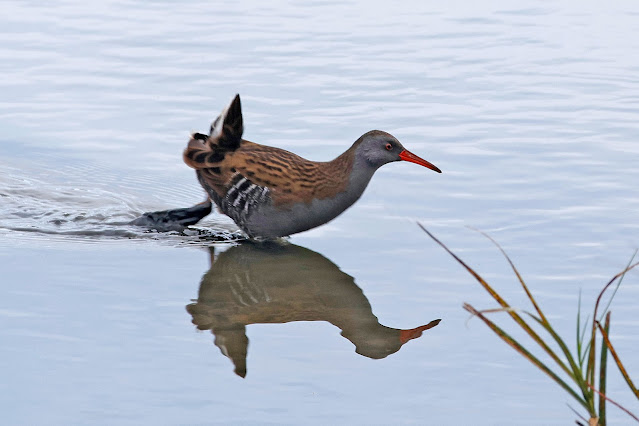It was back to Titchfield Haven, this time I decided to park at Bridge Street car park and walk the Canal Path to the reserve, and then walking back later. Leaving the car park there were Chiffchaff calls all along the canal, mostly coming from the willows. I waited at a patch of sunlight and one showed very well.
As I approached Posbrook Floods I could see egrets and as I got closer I was able to identify them as Great Egrets, two were at the back of the floods, with two Little Egrets, one Great Egret flew into the deeper reeds and out of sight, but one showed well.
A little further along I could hear the mewing calls of a Buzzard, scanning across I found it on a branch of a tree in the middle of the marsh. With the light it was silhouetted producing a lovely scene.
For the rest of the walk it was more Chiffchaffs, a few Jays and in the fields around Hammonds Bridge a good number of Pied Wagtails.
I walked around the chalets and then down on to the beach. A Common Gull was out on the mud. Always a nice gull to photograph
Offshore what I thought was a buoy turned out to be a Grey Seal spy hopping. Here tghe front of the seal.
I walked to the visitor centre, stopping at the bridge, not expecting to see a Kingfisher and flushed one from the perch!
I came back to the west side and went to the Meon Shore Hide. The scene from the hide was not dissimilar to that from the last visits with most of the birds away to the north side.
A Water Rail call from the left side of the hide alerted the hide to a possible sighting and soon after one appeared.
Then sped across in front or the hide to the reeds on the right hand side.
There were the usual waders on the scrape, Redshank, Lapwing, Black-tailed Godwits, Snipe and a good count of 26 Avocet, but the best wader was a Green Sandpiper that predictably could be seen on the far causeway of the south scrape.
The clouds started to thin out and we were treated to some autumn sunshine, the blue sky reflecting in the waters of the scrape.
As always there was a Lapwing around the small island in front of the hide and it was reflecting nicely in the blue still water.
Another feature of the Lapwing is that they continually spook themselves and take off at the slightest thing, sometimes the other birds join them, today the Avocet decided to go and they also took some Black-tailed Godwits with them.
The Avocet though soon returned to the scrape.
A Marsh Harrier appeared, dropping down behind the reeds at the back of the scrape, interestingly this did not spook the birds on scrape. There was also a Sparrowhawk sat on the fence and this dropped on to the ground and wasn't seen again.
There were good numbers of Shoveler over the scrape, all in various stages of the ir moult, some nearly there while others had a way to go. The were a little restless and would take off and fly around calling with their guttural croaks.
But it was back to the Lapwing, Godwits and Avocet as they all went up once again.
A couple of Black-tailed Godwits just about to pass over the roof of the hide.
All the letters have been removed from the islands around the scrape, the reason being cited is it makes things look more natural for photographers? The islands today were constantly covered with Starling and every so often they would fly in and bathe on the edge of the island, this makes for an interesting spectacle as their ablutions send water everywhere.
It was time to move so I left and headed back along the Canal Path to the car park at Bridge Street. There were still quite a few calling Chiffchaffs and a group of 5 Mistle Thrush just past Hammonds Bridge was interesting, the first time I have had Mistle Thrush along the canal path.
About half way I came across this Kestrel hunting in the field.
The Red Admiral movement continued through the day and they were never seen stopping, however this Peacock settled on the path in front of me, quite stunning.
It struck me then how we have become so accepting of these wading birds now, only a few years ago to see these three species together would be a major event.
Leaving the Floods I made my way to the car. A check of the owl tree revealed nothing. On the journey home I nearly hit a Red Kite as it dropped to take road kill from the tarmac in front of my car.




















































No comments:
Post a Comment